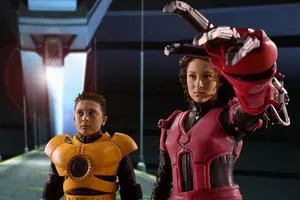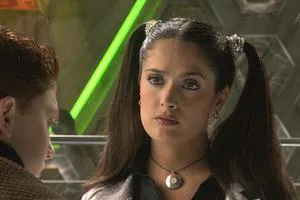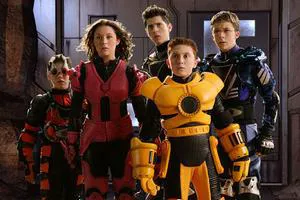
They all came to shine in this strictly children’s film out of respect for Robert Rodriguez – not only a cult director but also a playwright, producer, composer, cinematographer, artist, editor, and special effects artist. Everyone except Stallone didn’t last more than thirty seconds on screen. Stallone lasted about four minutes. Because the most important thing in “Spy Kids 3-D: Game Over” isn’t the stars, but the computer game we find ourselves inside. The superstar parade is just one of the gimmicks here. Because the most important thing in “Spy Kids 3-D: Game Over” isn’t the stars, but the computer game we find ourselves inside. The superstar parade is just one of the gimmicks here.
The first two installments of this film comic went downhill – from a very decent first to a very mediocre second. The third part needed to surprise with something. In my opinion, Rodriguez succeeded. He completely shifted the viewer’s focus from plot pleasures to special effects and created an ideal attraction like a computer adventure. He invested a lot of imagination and technical ingenuity in this, inventing and building a cyberspace in the spirit of the most advanced modern games, and sometimes even surpassing that level. He demonstrated a remarkable knowledge of the laws and psychology of video games and even tried to simulate the excitement, which has no support in cinema because we are not gamers with joysticks in hand, but viewers with popcorn. The picture is exciting and boring at the same time – depending on the mood of each individual. And the teenage audience from the cinema in the Moscow “Atrium” came out either in complete delight, or someone even staged a protest, chanting from the escalator into the crowd: don’t go to this movie – it’s a rip-off! And the range of critical assessments in the American press is also considerable – from “monstrous” to “very good.”
Plot and Visuals

Paying attention to the plot here is pointless – it’s impossibly stupid: thirteen-year-old agent Carmen Cortez, with the help of her paralyzed superhero grandfather, must save the future of humanity, as well as her sister stuck in cyberspace, by neutralizing the new product of a computer villain – a trap game for all the children of the planet. He needs to pass five levels and pull the switch lever. The setting vividly resembles countless game hits, from DOOM to SimCity, but the dynamism is maximum, the screen is huge, and we are as if inside this virtual world, which is unstable, changeable, and there is nowhere to step without the risk of losing solid ground under your feet. The film is 90 percent animated: the environment is entirely modeled on a computer, and live actors are often replaced by virtual copies, which, it must be said, is too noticeable. But, unlike the computer, we cannot influence events in any way – we can only “cheer.”
The 3D Experience

And here is the main joke of the film, which some mercilessly scold, complaining of headaches, while others praise to the skies, which is again unfair. Rodriguez shot the film in two versions: ordinary, two-dimensional, and 3-D, volumetric. And if the cinema is good, then at the box office, along with the ticket, you will be given glasses, which you will put on at the right moment on command from the screen, struggling with the string – the glasses are extremely uncomfortable. They have nothing in common with the high-quality and rather expensive glasses that are issued in IMAX cinemas, and the film in the projector is the most ordinary. Therefore, there is no longer that clarity when every pore on the skin is visible, but the feeling of volume still arises, which makes some episodes very effective. The stereo system chosen by Rodriguez is almost no different from the one that amazed the public in the Moscow cinema “October” in the 80s. The light filters in the glasses are one bright red, the other intensely green, together they noticeably reduce the color of the film, so you look as if through a dusty glass at a slightly blurred, almost monochrome, but three-dimensional picture, with which the hero Stallone unsuccessfully tries to drive you with his fist in the nose. The glasses are exactly the same as the heroes of the film, only cardboard and remain with you as a souvenir.
Family Values

Apparently, paternal concerns about his own children prompted Rodriguez to completely abandon his former Tarantino cynicism and make a film not only entertaining but also educational.
In between the cool special effects, it promotes family values, sounds heartfelt words about attention to older generations, and much more that the most independent of viewers will actively dislike.